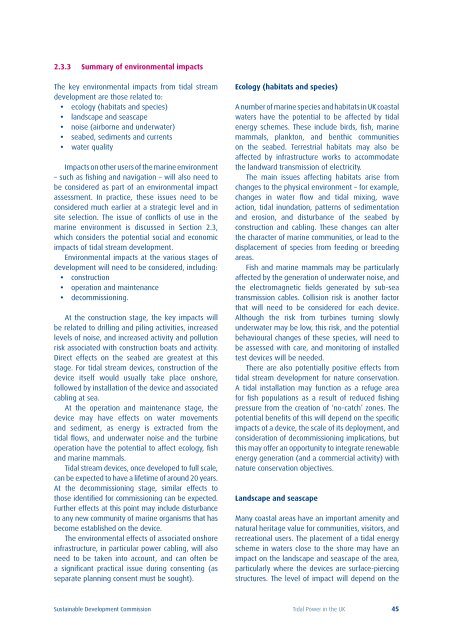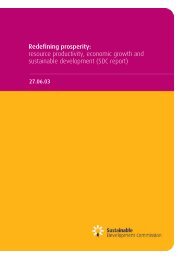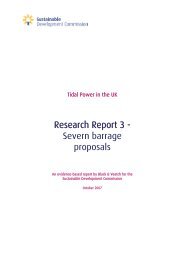Tidal Power in the UK - Sustainable Development Commission
Tidal Power in the UK - Sustainable Development Commission
Tidal Power in the UK - Sustainable Development Commission
You also want an ePaper? Increase the reach of your titles
YUMPU automatically turns print PDFs into web optimized ePapers that Google loves.
2.3.3 Summary of environmental impactsThe key environmental impacts from tidal streamdevelopment are those related to:• ecology (habitats and species)• landscape and seascape• noise (airborne and underwater)• seabed, sediments and currents• water qualityImpacts on o<strong>the</strong>r users of <strong>the</strong> mar<strong>in</strong>e environment– such as fish<strong>in</strong>g and navigation – will also need tobe considered as part of an environmental impactassessment. In practice, <strong>the</strong>se issues need to beconsidered much earlier at a strategic level and <strong>in</strong>site selection. The issue of conflicts of use <strong>in</strong> <strong>the</strong>mar<strong>in</strong>e environment is discussed <strong>in</strong> Section 2.3,which considers <strong>the</strong> potential social and economicimpacts of tidal stream development.Environmental impacts at <strong>the</strong> various stages ofdevelopment will need to be considered, <strong>in</strong>clud<strong>in</strong>g:• construction• operation and ma<strong>in</strong>tenance• decommission<strong>in</strong>g.At <strong>the</strong> construction stage, <strong>the</strong> key impacts willbe related to drill<strong>in</strong>g and pil<strong>in</strong>g activities, <strong>in</strong>creasedlevels of noise, and <strong>in</strong>creased activity and pollutionrisk associated with construction boats and activity.Direct effects on <strong>the</strong> seabed are greatest at thisstage. For tidal stream devices, construction of <strong>the</strong>device itself would usually take place onshore,followed by <strong>in</strong>stallation of <strong>the</strong> device and associatedcabl<strong>in</strong>g at sea.At <strong>the</strong> operation and ma<strong>in</strong>tenance stage, <strong>the</strong>device may have effects on water movementsand sediment, as energy is extracted from <strong>the</strong>tidal flows, and underwater noise and <strong>the</strong> turb<strong>in</strong>eoperation have <strong>the</strong> potential to affect ecology, fishand mar<strong>in</strong>e mammals.<strong>Tidal</strong> stream devices, once developed to full scale,can be expected to have a lifetime of around 20 years.At <strong>the</strong> decommission<strong>in</strong>g stage, similar effects tothose identified for commission<strong>in</strong>g can be expected.Fur<strong>the</strong>r effects at this po<strong>in</strong>t may <strong>in</strong>clude disturbanceto any new community of mar<strong>in</strong>e organisms that hasbecome established on <strong>the</strong> device.The environmental effects of associated onshore<strong>in</strong>frastructure, <strong>in</strong> particular power cabl<strong>in</strong>g, will alsoneed to be taken <strong>in</strong>to account, and can often bea significant practical issue dur<strong>in</strong>g consent<strong>in</strong>g (asseparate plann<strong>in</strong>g consent must be sought).Ecology (habitats and species)A number of mar<strong>in</strong>e species and habitats <strong>in</strong> <strong>UK</strong> coastalwaters have <strong>the</strong> potential to be affected by tidalenergy schemes. These <strong>in</strong>clude birds, fish, mar<strong>in</strong>emammals, plankton, and benthic communitieson <strong>the</strong> seabed. Terrestrial habitats may also beaffected by <strong>in</strong>frastructure works to accommodate<strong>the</strong> landward transmission of electricity.The ma<strong>in</strong> issues affect<strong>in</strong>g habitats arise fromchanges to <strong>the</strong> physical environment – for example,changes <strong>in</strong> water flow and tidal mix<strong>in</strong>g, waveaction, tidal <strong>in</strong>undation, patterns of sedimentationand erosion, and disturbance of <strong>the</strong> seabed byconstruction and cabl<strong>in</strong>g. These changes can alter<strong>the</strong> character of mar<strong>in</strong>e communities, or lead to <strong>the</strong>displacement of species from feed<strong>in</strong>g or breed<strong>in</strong>gareas.Fish and mar<strong>in</strong>e mammals may be particularlyaffected by <strong>the</strong> generation of underwater noise, and<strong>the</strong> electromagnetic fields generated by sub-seatransmission cables. Collision risk is ano<strong>the</strong>r factorthat will need to be considered for each device.Although <strong>the</strong> risk from turb<strong>in</strong>es turn<strong>in</strong>g slowlyunderwater may be low, this risk, and <strong>the</strong> potentialbehavioural changes of <strong>the</strong>se species, will need tobe assessed with care, and monitor<strong>in</strong>g of <strong>in</strong>stalledtest devices will be needed.There are also potentially positive effects fromtidal stream development for nature conservation.A tidal <strong>in</strong>stallation may function as a refuge areafor fish populations as a result of reduced fish<strong>in</strong>gpressure from <strong>the</strong> creation of ‘no-catch’ zones. Thepotential benefits of this will depend on <strong>the</strong> specificimpacts of a device, <strong>the</strong> scale of its deployment, andconsideration of decommission<strong>in</strong>g implications, butthis may offer an opportunity to <strong>in</strong>tegrate renewableenergy generation (and a commercial activity) withnature conservation objectives.Landscape and seascapeMany coastal areas have an important amenity andnatural heritage value for communities, visitors, andrecreational users. The placement of a tidal energyscheme <strong>in</strong> waters close to <strong>the</strong> shore may have animpact on <strong>the</strong> landscape and seascape of <strong>the</strong> area,particularly where <strong>the</strong> devices are surface-pierc<strong>in</strong>gstructures. The level of impact will depend on <strong>the</strong>Susta<strong>in</strong>able <strong>Development</strong> <strong>Commission</strong> <strong>Tidal</strong> <strong>Power</strong> <strong>in</strong> <strong>the</strong> <strong>UK</strong> 45








